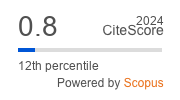Application of numerical simulation in investigation of memristor structures based on oxides and chalcogenides
https://doi.org/10.17073/1609-3577-2019-4-246-252
Abstract
Keywords
About the Authors
V. V. SirotkinRussian Federation
Vadim V. Sirotkin: Cand. Sci. (Phys.-Math.), Leading Researcher
N. A. Tulina
Russian Federation
Nataliya A. Tulina: Cand. Sci. (Phys.-Math.), Senior Researcher
References
1. Strukov D. B., Snider G. S., Stewart D. R., Williams R. S. The missing memristor found. Nature, 2008, vol. 453, pp. 80—83. DOI: 10.1038/nature06932
2. Ventra M. D., Pershin Yu. V., Chua L. O. Circuit elements with memory: memristors, memcapacitors, and meminductors. Proc. IEEE, 2009, vol. 97, no. 10, pp. 1717—1724. DOI: 10.1109/JPROC.2009.2021077
3. Jeong D. S., Thomas R., Katiyar R. S., Scott J. F., Kohlstedt H., Petraru A., Hwang Ch. S. Emerging memories: resistive switching mechanisms and current status. Rep. Prog. Phys., 2012, vol. 75, no. 7, art. no. 076502. DOI: 10.1088/0034-4885/75/7/076502
4. Yang J. J., Strukov D. B., Stewart D. R. Memristive devices for computing. Nature Nanotech., 2013, vol. 8, pp. 13—24. DOI: 10.1038/nnano.2012.240
5. Petrov A., Alekseeva L., Ivanov A., Luchinin V., Romanov A., Chikyow T., Nabatame T. On the way to a neuromorphic memristor computer platform. Nanoindustry. 2016, no. 1, pp. 94—109. DOI: 10.22184/1993-8578.2016.63.1.94.109
6. Pershin Yu. V., Ventra M. D. Memory effects in complex materials and nanoscale systems. Adv. Phys., 2011, vol. 60, pp. 145—227. DOI: 10.1080/00018732.2010.544961
7. Tulina N. A., Sirotkin V. V. Electron instability in doped-manganites-based heterojunctions. Physica C: Superconductivity, 2004, vol. 400, no. 3–4, pp. 105—110. DOI: 10.1016/j.physc.2003.07.002
8. Tulina N. A., Borisenko I. Yu., Sirotkin V. V. Reproducible resistive switching effect for memory applications in heterocontacts based on strongly correlated electron systems. Phys. Lett. A, 2008, vol. 372, no. 44, pp. 6681—6686. DOI: 10.1016/j.physleta.2008.09.015
9. Tulina N. A., Borisenko I. Yu., Sirotkin V. V. Bipolar resistive switchings in Bi2Sr2CaCu2O8+δ. Solid State Communications, 2013, vol. 170, pp. 48—52. DOI: 10.1016/j.ssc.2013.07.023
10. Tulina N. А., Rossolenko А. N., Shmytko I. М., Кolesnikov N. N., Borisenko D. N., Bozhko S. I., Ionov А. М. Rectification and resistive switching in mesoscopic heterostructures based on Bi2Se3. Materials Letters, 2015, vol. 158, pp. 403—405. DOI: 10.1016/j.matlet.2015.06.060
11. Tulina N. A., Rossolenko A. N., Ivanov А. А., Sirotkin V. V., Shmytko I. M., Borisenko I. Yu., Ionov А. М. Nd2-xCexCuO4-y/Nd2-xCexOy boundary and resistive switchings in mesoscopic structures on base of epitaxial Nd1.86Ce0.14CuO4-у films. Physica C: Superconductivity and its Applications, 2016, vol. 527, pp. 41—45. DOI: 10.1016/j.physc.2016.05.015
12. Sirotkin V. V., Tulina N. A., Rossolenko A. N., Borisenko I. Yu. Numerical simulation of resistive switching in heterostructures based on anisotropic oxide compounds. Bull. Russ. Acad. Sci. Phys., 2016, vol. 80, no. 5, pp. 497—499. DOI: 10.3103/S1062873816050191
13. Tulina N. A., Rossolenko A. N., Shmytko I. M., Kolesnikov N. N., Borisenko D. N., Sirotkin V. V., Borisenko I. Y. Frequency properties of heterostructures based on bismuth selenide upon bipolar resistive switching: Experiments and numerical simulation. Bull. Russ. Acad. Sci. Phys., 2016, vol. 80, no. 6, pp. 672—674. DOI: 10.3103/S1062873816060381
14. Tulina N. A. Memristor properties of high temperature superconductors. URL: https://arxiv.org/abs/1801.09428
15. Tulina N. A., Rossolenko A. N., Shmytko I. M., Ivanov А. А., Sirotkin V. V., Borisenko I. Yu., Tulin V. A. Properties of percolation channels in planar memristive structures based on epitaxial films of a YBa2Cu3O7-δ high temperature superconductor. Supercond. Sci. Technol., 2018, vol. 32, no. 1, art. no. 015003. DOI: 10.1088/1361-6668/aae966
16. Tulina N. A., Rossolenko A. N., Shmytko I. M., Kolesnikov N. N., Borisenko D. N., Sirotkin V. V., Borisenko I. Y., Tulin V. A. Studying the dynamic effects in memristive structures based on bismuth selenide: does a memristor need a shuttle tail? Bull. Russ. Acad. Sci. Phys., 2019, vol. 83, no. 6, pp. 740—744. DOI: 10.3103/S1062873819060340
17. Tulina V. A., Rossolenko A. N., Shmytko I. M., Ivanov A. A., Ionov A. M., Bozhko S. I., Borisenko I. Yu., Sirotkin V. V., Tulin V. A. Functional properties of anisotropic perovskite compounds in memristor structures for application in electronics. Nanoindustry, 2019, no. S, pp. 237—240. URL: http://www.nanoindustry.su/files/article_pdf/7/article_7591_5.pdf
18. Marchuk G. I. Metody vychislitel’noi matematiki [Methods of Computational Mathematics]. Moscow: Nauka, 1977, 456 p. (In Russ.)
19. Trottenberg U., Oosterlee C. W., Schüller A. Multigrid. London: Acad. Press, 2001. 631 p.
20. Sirotkin V. V. Highly efficient decomposition algorithm for modeling thermal modes of powerful transistors. Fundamental’nye problemy radioelektronnogo priborostroeniya, 2016, vol. 16, no. 3, pp. 181—183. (In Russ.)
Review
For citations:
Sirotkin V.V., Tulina N.A. Application of numerical simulation in investigation of memristor structures based on oxides and chalcogenides. Izvestiya Vysshikh Uchebnykh Zavedenii. Materialy Elektronnoi Tekhniki = Materials of Electronics Engineering. 2019;22(4):246-252. (In Russ.) https://doi.org/10.17073/1609-3577-2019-4-246-252






































